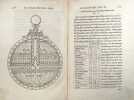ROJAS SARMIENTO, Juan de
Commentariorum in astrolabium, quod planispherium vocant, libri sex nunc primùm in lucem editi.
Paris, Michel Vascosan, 1551.
Reference : 17967
Ce rare traité décrit deux modèles d'astrolabe. Il est illustré de plus de 60 bois gravés, certains à pleine page. D'une famille castillane noble, Juan de Rojas suivit la cour de Charles-Quint dans les Flandres. Il fréquenta luniversité de Louvain, où il suivit les cours de Gemma Frisius, qui devint par la suite son ami. Il se rendit célèbre dans toute l'Europe, en proposant une astrolabe qui utilisait une projection orthographique de la sphère céleste. Le livre V est un commentaire des écrits de Gemma Frisius sur l'astrolabe. Seconde édition, identique à la première de 1550, un seul bois d'après Mortimer est différent. Mortimer, Harvard calogue 462. Brun, Le livre français illustré de la Renaissance 283. Bon exemplaire. /// In-4 de (24), 281, (3), (12) pp. Vélin. (Reliure de la fin du XIXe.) //// Rojas describes two new types of astrolabe that he developed using an orthographic projection of the celestial sphere. Illustrated by 60 woodcuts. "The chief novelty in both [astrolabes] consisted in a special treatment of the face of the instrument as an orthographic projection of the sphere on the plane of the meridian." (Gunther, Astrolabes of the World). "A scion of the Castilian nobility, Juan de Rojas moved to Flanders with the court of Emperor Charles V and studied with Reiner Gemma Frisius in Louvain. He became famous in Europe mainly thanks to the dissemination of a new type of astrolabe that he developed using an orthographic projection of the celestial sphere. The instrument was unveiled in 'Commentariorum in astrolabium', a widely circulated treatise published in Paris in 1551." (Museo Galileo). Second edition, similar to the first of 1550.
Bookseller's contact details
Hugues de Latude
Hugues de Latude
06 09 57 17 07
Payment mode



Sale conditions
Books are guaranteed to be complete and in good condition unless otherwise stated.
 Write to the booksellers
Write to the booksellers





